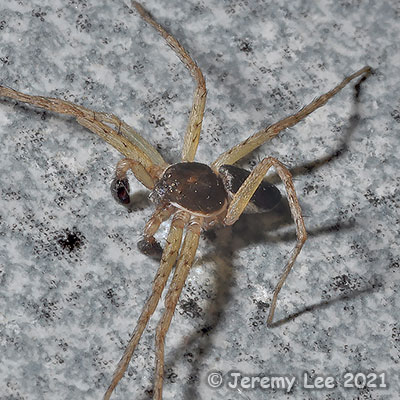
 |
|
Scientific Classifications explained » Amphibians » Ants » Aphids » Bees » Beetles » Birds » Bugs » Butterflies » Caterpillars » Damselflies » Dragonflies » Earwigs » Flies » Frog/Leafhoppers » Fungi » Galls » Grasshoppers » Harvestmen » Hoverflies » Lacewings » Ladybirds » Leaf Mines » Lichens » Mammals » Millipedes » Mosses » Moths » Sawflies » Slugs » Snails » Spiders » Trees & Shrubs » Wasps » Wild Flowers » Woodlice » Postboxes |
UK Nature > Spiders > Philodromus dispar

Scientific Name: Philodromus dispar Common Name: Running Crab Spider Philodromus dispar is widespread in much of the southern half of Britain, with records petering out the further north and west you go. It is found in a variety of wooded habitats including broad-leaved, mixed and coniferised woods, thickets, hedgerows, scrub, gardens and it sometimes comes into houses - indeed the male in the photo above was discovered walking across the work surface in my kitchen in late February, which is a very early sighting for the species. It can be swept from woodland herbage and the lower branches of trees and bushes. The spider appears to over-winter in litter, especially in leaf litter and the litter which accumulates at the bottom of hedgerows, in tree boles and at the base of branches. Adults of both sexes are found mainly in early summer, females occasionally persisting into the autumn and winter. |
|

https://www.uknature.co.uk is a website dedicated to showing the immense diversity of UK nature and wildlife. Our vast range of habitats, from lowland arable to snow covered mountains, from storm-ravaged coastlines to peaceful inland freshwater lakes and rivers, from dry, sandy heaths to deciduous and coniferous forests, all these habitats contribute to the abundance of UK nature. We have wild birds in huge numbers either residing or visiting our shores (597 recorded species as at July 2013) and we must also not forget the humble back garden with its grass lawns, flower beds filled with nectar rich flowers, shrubs and trees, all designed to attract huge numbers of insects such as bees, moths, butterflies and hoverflies; and finally the small ponds which provide safe havens for frogs, toads, newts and even slow worms and grass snakes. www.uknature.co.uk is the showcase for my personal passion, photographing uknature in all its glory. I sincerely hope you all enjoy the fruits of my labours. This site and all images contained therein is © Jeremy Lee 2004 - 2025. All Rights Reserved. Site design by Jeremy Lee. Site development & IT Support by Stuart Lee. |